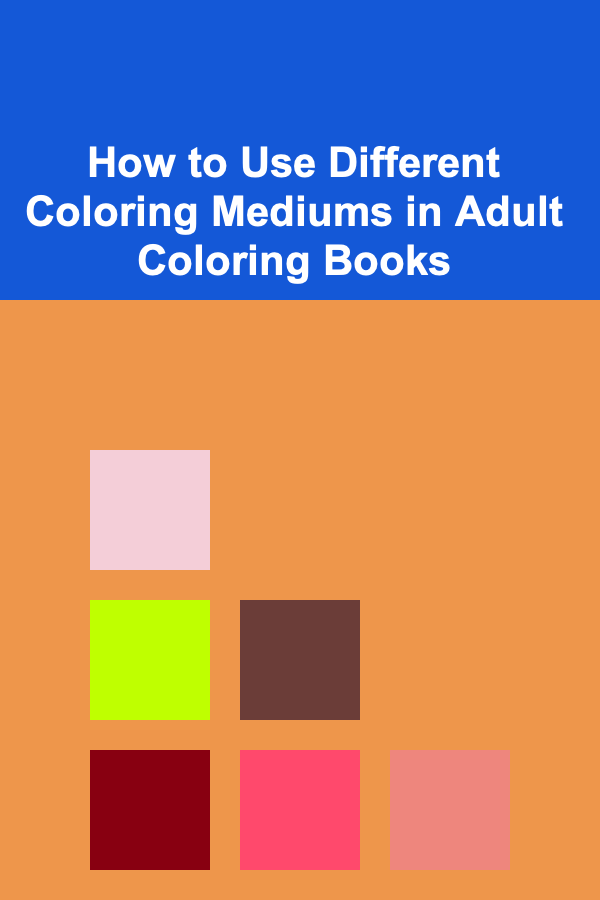
How to Use Different Coloring Mediums in Adult Coloring Books
ebook include PDF & Audio bundle (Micro Guide)
$12.99$9.99
Limited Time Offer! Order within the next:

Adult coloring books have surged in popularity over recent years as a therapeutic and creative outlet. With their intricate designs and high-quality paper, adult coloring books offer a more sophisticated and relaxing experience compared to traditional children's coloring books. As you explore the world of adult coloring, one key factor that enhances the artistry of your work is choosing the right coloring medium. Whether you prefer pencils, markers, paints, or gel pens, each medium has unique advantages and techniques for creating stunning, vibrant results.
In this article, we will dive into how to use different coloring mediums effectively in adult coloring books, including the tools required, tips for optimal results, and considerations for selecting the right medium for your desired effect. Understanding how different mediums interact with paper will allow you to elevate your artwork and transform your coloring experience into an enjoyable and calming process.
Colored Pencils: The Classic Medium
Colored pencils are one of the most commonly used and versatile mediums for adult coloring books. They are easy to use, portable, and offer a range of effects, from soft shading to vibrant details.
Types of Colored Pencils
- Wax-Based Pencils: These are the most common type of colored pencils. They are smooth and easy to blend but may leave a waxy residue on the page.
- Oil-Based Pencils: Oil-based pencils tend to be firmer and are less prone to breaking. They are known for their richer pigmentation and smooth application.
- Water-Soluble Pencils: These pencils can be used dry like traditional colored pencils or activated with water to create watercolor-like effects.
Tips for Using Colored Pencils
- Layering: Build up color slowly by layering light strokes. This allows you to control the depth of the color and blend smoothly.
- Blending: To achieve smooth transitions, use a blending pencil or a colorless blender. You can also use baby oil or a solvent like mineral spirits to blend colors and create a softer look.
- Shading: Use a light touch for shading to avoid hard lines. Start with a light color and gradually add darker shades, following the contours of the image to create depth.
- Texture: By varying the pressure on your pencil, you can achieve different textures. Light pressure produces soft, smooth color, while heavier pressure results in darker, more intense color.
- Paper Type: Colored pencils work best on smooth, high-quality paper with a slight texture that allows the pigment to grip.
Colored pencils are ideal for creating fine details and soft, gradient effects, making them perfect for intricate patterns and realistic shading in adult coloring books.
Markers: Bold and Vibrant
Markers are another popular medium for adult coloring, especially for those who enjoy bold, vibrant colors. They are perfect for creating solid, uniform color and for achieving quick, striking results.
Types of Markers
- Alcohol-Based Markers: These markers offer rich, vibrant colors and are highly blendable. They work best on smooth, thick paper and can produce stunning gradients and shading effects.
- Water-Based Markers: While less intense in color than alcohol markers, water-based markers are easier to clean up and less likely to bleed through the paper. They are a great option for detailed designs and can be used in conjunction with water for watercolor effects.
Tips for Using Markers
- Test for Bleeding: Some adult coloring books use thinner paper, which can cause markers to bleed through. Always test your markers on a scrap piece of paper before starting to ensure they won't seep through to the next page.
- Layering and Blending: Alcohol markers can be blended to create smooth transitions between colors. Start with a light layer and build up darker shades. Water-based markers are less blendable, but you can use a water brush to create softer edges.
- Avoid Overloading: To prevent your markers from smudging, don't oversaturate the paper with ink. This is particularly important with water-based markers, as they may cause the paper to warp.
- Color Consistency: Markers provide vibrant, consistent color in each stroke, but be mindful of even coverage to avoid streaks or uneven coloration.
Markers are excellent for quick, bold coloring, and they are especially effective for creating vibrant backgrounds, graphic designs, or flat, even color in your artwork.
Gel Pens: Smooth and Glossy
Gel pens have become a popular choice for adult coloring enthusiasts who seek smooth, detailed coloring with a glossy finish. These pens are available in a variety of colors and finishes, including metallic, glitter, and neon, which makes them perfect for adding highlights and accents to your designs.
Tips for Using Gel Pens
- Layering: Gel pens are ideal for adding intricate details and highlights over colored pencil or marker work. Be sure to wait for the previous layer to dry before adding additional colors.
- Avoid Smudging: Gel pens can smudge easily, so it's important to let your work dry completely before handling the page.
- Finishing Touches: Use gel pens for fine details, outlining, and accents such as small flowers, stars, or text. Their fine tips allow for precise control and beautiful, glossy finishes.
- Paper Type: Gel pens work best on smooth, high-quality paper. If your coloring book has thin pages, be cautious of bleeding or ink transfer.
Gel pens are perfect for creating special effects, such as metallic details or subtle accents, making them a great addition to any adult coloring project.
Watercolors: Fluid and Expressive
Watercolors offer a unique, artistic approach to adult coloring, allowing for beautiful washes of color and a more painterly effect. This medium is especially suited for those who enjoy experimenting with texture and blending.
Types of Watercolors
- Traditional Watercolors: These come in tubes or pans and require a brush and water. They are great for creating soft washes and blending.
- Watercolor Pencils: These can be used like regular colored pencils but become soluble when activated with water. They offer more control over the application and are easier to manipulate than traditional watercolors.
Tips for Using Watercolors
- Start Light: Watercolors are known for their transparency, so begin with light washes and gradually build up layers to achieve depth and vibrancy.
- Control Water Usage: The key to good watercoloring is balancing water and pigment. Too much water can lead to muddiness, while too little can result in a dry, streaky appearance.
- Brush Techniques: Use different brush sizes to vary the strokes, from broad washes to fine details. You can also experiment with dry brushing for texture and definition.
- Paper Type: Watercolors work best on thick, absorbent paper, such as watercolor paper or high-quality mixed media paper. Be cautious with thinner paper, as it may buckle or tear under the water.
Watercolors are perfect for creating fluid, organic effects and adding a more painterly aesthetic to your adult coloring projects.
Pastels: Soft and Dreamy
Pastels, both oil and soft, are a great choice for artists looking to create soft, ethereal effects. They can be applied directly to the paper or blended for a smoother finish.
Types of Pastels
- Oil Pastels: These provide a creamy texture and are easy to blend, but they tend to leave a greasy residue on the paper.
- Soft Pastels: These are more powdery and are ideal for blending and creating soft gradients. They can be easily smudged for a smoky effect.
Tips for Using Pastels
- Blend with Fingers or Tools: Pastels are perfect for blending with your fingers or blending tools. Soft pastels blend easily, allowing for smooth transitions of color.
- Fixative: Because pastels are prone to smudging, it's a good idea to use a fixative spray to set your work and prevent it from smearing.
- Layering: Layer colors gradually to achieve depth and richness. Pastels work well for creating soft, blended backgrounds and subtle shading effects.
Pastels are ideal for creating soft, dreamy effects, and they are especially effective for blending colors in large areas.
Crayons: Simple and Fun
Crayons are a fun and nostalgic medium for adult coloring. While they may not offer the same precision as colored pencils or markers, they are an excellent choice for those who want to relax and color without worrying too much about technique.
Tips for Using Crayons
- Vibrant Coverage: Crayons are great for quick, vibrant color. Their waxy texture can be used to fill in large areas, but they may not allow for detailed work.
- Layering: Crayons can be layered to build up color depth, but be mindful of their tendency to leave a waxy residue.
- Smoothness: You can smooth out crayon color by applying light pressure or using a blending tool to soften lines.
Crayons are perfect for simple, carefree coloring, providing vibrant coverage with minimal effort.
Conclusion
Choosing the right coloring medium for your adult coloring book is a personal decision that depends on your artistic goals and preferences. Each medium offers unique advantages, and experimenting with different tools can open up new possibilities for creativity. Whether you choose colored pencils for their fine details, markers for their bold colors, or watercolors for their fluidity, the possibilities are endless. The key is to explore different techniques and enjoy the process of bringing your coloring book to life.
By understanding the characteristics of each medium and applying the right techniques, you can create artwork that is not only beautiful but also a source of relaxation and joy. Happy coloring!
Reading More From Our Other Websites
- [Home Family Activity 101] How to Build with Cardboard Boxes for Creative Family Fun
- [Organization Tip 101] How to Use Multi-functional Furniture in Your Laundry Space
- [Personal Financial Planning 101] How to Set Up a Will and Estate Plan for Peace of Mind
- [Stamp Making Tip 101] Ink & Impressions: Combining Calligraphy with Hand‑Made Stamps for Artistic Mastery
- [Home Holiday Decoration 101] How to Choose Festive Holiday Gifts That Double as Decor
- [Personal Care Tips 101] How to Choose Sunscreen for Your Kids and Babies
- [Personal Care Tips 101] How to Remove Old Nail Polish with Nail Polish Remover
- [Personal Care Tips 101] How to Take Care of Your Perfume Bottles
- [Personal Care Tips 101] How to Choose the Best Deodorant for Sensitive Skin and Allergies
- [Home Party Planning 101] How to Plan a Budget-Friendly Home Party Without Sacrificing Fun

How to Incorporate Sustainable Decor into Your Home on a Budget
Read More
How to Use a Third-Party Logistics (3PL) Service for International Dropshipping Shipping
Read More
How To Choose the Right Bed for Your Pet
Read More
How To Generate Leads with Content Marketing: A Comprehensive Guide
Read More
How to Understand Inflation and Its Impact
Read More
10 Tips for Mastering the Pilates Roll-Up
Read MoreOther Products

How to Incorporate Sustainable Decor into Your Home on a Budget
Read More
How to Use a Third-Party Logistics (3PL) Service for International Dropshipping Shipping
Read More
How To Choose the Right Bed for Your Pet
Read More
How To Generate Leads with Content Marketing: A Comprehensive Guide
Read More
How to Understand Inflation and Its Impact
Read More